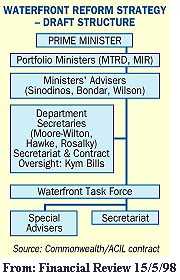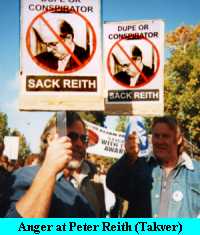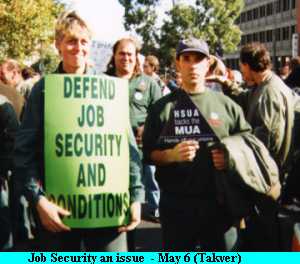THE PATRICK CORPORATE SCAM

Patrick engaged in a corporate restructure in September 1997. Before the restructuring four companies in the Patrick Group operated a profitable Stevedoring business.
These companies:
- employed the workers
- held the wharf leases with various state Port Authorities around the country
- owned the equipment
- had contracts with shipping companies to load and unload cargo and dispatch cargo from the wharves;
and
- made a profit.
In September 1997 a corporate restructure was secretly put in place

- The equipment was taken out of the stevedoring companies and placed 'upstream' in another company. The contracts with shippers, importers and exporters were taken out of the stevedoring companies and placed 'upstream' in yet another company.
- $300m of working capital, was stripped out of the companies and placed 'upstream' including all accrued entitlements to annual leave, LSL, sick leave, employee superannuation contribution and six months of worker's private health care contributions.
- In a share buy back the stevedoring companies paid Corrigan and Scanlan a further $60-$70m.
- The workers were left in the stevedoring companies that had been stripped of their assets.
- Debt of $270m was also left in these companies.
The profit making stevedoring companies were restructured. They became labor hire companies devoid of equipment, devoid of the stevedoring business, devoid of port leases, devoid of money, and holding a $270m debt.
A secret labor hire contract was signed. Corrigan used a trap in the secret contract, that there be no interruption to work to circumvent Reith's own industrial laws. Legal industrial action to secure an enterprise agreement was used by Corrigan to terminate the contract.
The Patrick restructuring scam and secret contract allowed Patrick and Lang Corporation to effectively:
- retain workers accrued entitlements, unpaid wages, private health care and superannuation contributions;
- sack the MUA members;
- employ the non-union NFF replacement workforce;
- send the employing companies broke;
- argue wages and conditions and the number of jobs must be reduced because the asset stripped companies are not financially viable.
The Federal Government then said it would provide a guaranteed fund of $250m to pay out redundancy entitlements. This is the Government effectively paying $250m to the Lang Corporation and Patrick to cover for the $300m stripped out of the four stevedoring companies.

- Patrick and the Lang Corporation get $300m in asset stripping
- Corrigan and Scanlan get $60-$70m from a share buy back
- Patrick and the Lang Corporation get $250m from the Government to fund redundancies
- Union workers get the sack
- The Government gets the 'reform' of sacking every member of the union from Patrick companies
- The NFF gets to operate a non-union stevedore labor hire company.
The Patrick workers are back in the gate but the corporate scam continues...
The asset stripped employment companies are in the hands of administrators.
The secret labor hire contract provides payment for the labor. These amounts are not enough to:
- cover award and EBA rates and conditions
- cover the number of workers employed.
The intent of the corporate restructuring scam is to force:
- reductions to wages
- reductions to conditions
- reductions to the number ofjobs.
Corrigan says the restructured companies ate not viable. Corrigan's scam was designed to make them not viable in order to circumvent legally enforceable wages and conditions and/or force liquidation and sacking of all the union members.
 The corporate restructuring scam is available for any business in the country to use to:
The corporate restructuring scam is available for any business in the country to use to:
- retain workers' accrued entitlements
- sack workers
- employ replacement workers at lower rates and conditions.
No Worker Is Safe
The Government has aided and abetted Conigan's manoeuvres to circumvent the law.
The $250m guaranteed by the Government is at best an inducement or, at worst a direct payment for breaching the law.
Produced by the Australian union movement
(Source: Email to Takver 1/6/98)

Contact Takver with questions Or comments about this web page .
Last Modified : June 1, 1998




 The corporate restructuring scam is available for any business in the country to use to:
The corporate restructuring scam is available for any business in the country to use to:
